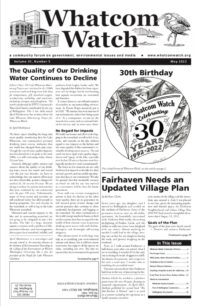Three recent reports examine the health of parts or all of the Salish Sea.
• “State of the Salish Sea,” May 25, 2021 — Report by the Salish Sea Institute of Western Washington University examines the most pervasive and damaging impacts affecting the transboundary ecosystem
• “Health of the Salish Sea Ecosystem Report,” July 13, 2021 — A collaboration between the U.S. EPA and Environment and Climate Change Canada to report to the public on the health of the shared ecosystem
• “State of the Sound,” November 1, 2021 — Seventh biennial report by the Puget Sound Partnership covering the area from the southern portion of Puget Sound to the Canadian border
Each attempt to gauge the health of the ecosystem. The “State of the Salish Sea” contains the most detail in providing a synthesis of recent scientific data. Both the EPA/Canada and State of the Sound reports designate criteria to indicate the overall health of the ecosystem, though the “State of the Sound” report focuses solely on U.S. waters.
Here are summary statements or health indicators from each of the reports:
“State of the Salish Sea” https://wp.wwu.edu/salishsea/
The Salish Sea is under relentless pressure from an accelerating convergence of global and local environmental stressors and the cumulative impacts of 150 years of development and alteration of our watersheds and seascape. The Salish Sea is compromised by the cumulative impacts of global climate change, regional urbanization and a growing population, and intensive human use and abuse across the ecosystem over the last two centuries.
“Health of the Salish Sea Report” https://www.epa.gov/salish-sea
Air indicators
• Air quality (Fine particulates) – Neutral
Species indicators
• Marine species at risk – Declining
• Chinook salmon – Declining
• Southern resident killer whales — Declining
• Toxics in the food web – Neutral
Water indicators
• Freshwater quality – Neutral
• Marine water quality – Declining
• Stream flow – Declining
Human well-being indicators
• Shellfish harvesting – Improving
• Swimming beaches – Neutral
“State of the Sound” https://stateofthesound.wa.gov
After more than 10 years of reporting indicators and comparing them to ecosystem recovery targets for 2020, patterns emerge:
• Few indicators reached their 2020 ecosystem recovery targets, signaling that ecosystem conditions are not good enough to say the system is resilient or recovered.
• We see the most progress for the habitat goal. Success arises in areas where decision-makers and land managers have direct influence on habitat outcomes, for example, restoring estuaries and floodplains or preventing conversion of ecologically sensitive lands. Many indicators in the habitat goal measure restoration and land conversion. Where our recovery community is involved, we see progress.
• We see the least progress in indicators affected by multiple factors (such as salmon and orca population abundance) and large-scale forces, such as climate change (which affects marine water quality), and where we rely on decisions made nationally or even globally to create positive change.
• Taken all together, indicators send mixed signals about the health of Puget Sound.
• About half of indicators are either not improving or getting worse.
• Many indicators are not trending in any direction.
• Some indicators show mixed results as conditions may be better or worse, depending on location.
• Most Puget Sound Vital Signs are changing slowly at best.
“State of the Salish Sea,” May 25, 2021.




























